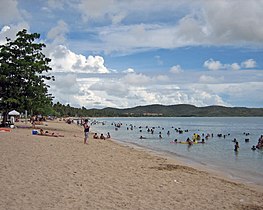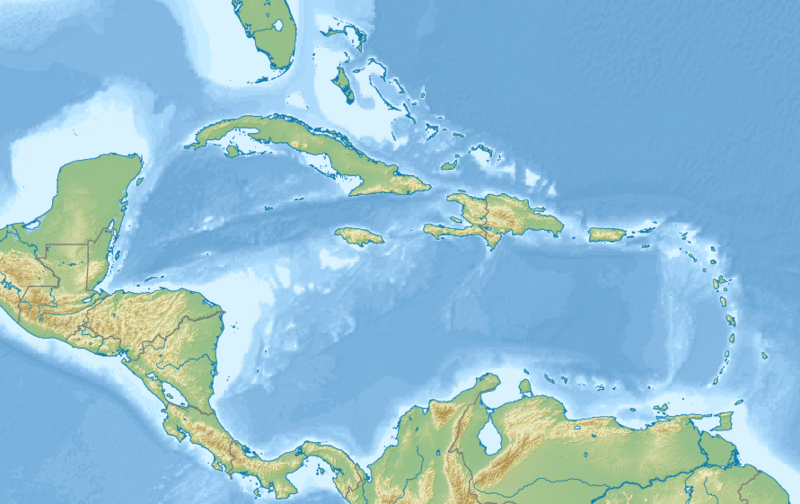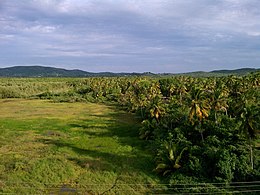Boquerón, Cabo Rojo, Puerto Rico
Boquerón is a barrio in the municipality of Cabo Rojo, Puerto Rico. Its population in 2010 was 5,373.[3][4][5][6] The village is one of the main tourist attractions in the southwestern part of the island.[7] In 2000, its population was 4,963.[8]
Boquerón | |
|---|---|
Barrio | |
 The Boquerón public beach, looking south | |
 Flag  Seal | |
 Location of Boquerón within the municipality of Cabo Rojo shown in red | |
 Boquerón Location of Puerto Rico | |
| Coordinates: 17°59′50″N 67°10′51″W[1] | |
| Commonwealth | |
| Municipality | |
| Area | |
| • Total | 15.88 sq mi (41.1 km2) |
| • Land | 12.50 sq mi (32.4 km2) |
| • Water | 3.38 sq mi (8.8 km2) |
| Elevation | 144 ft (44 m) |
| Population (2010) | |
| • Total | 5,373 |
| • Density | 516.4/sq mi (199.4/km2) |
| Source: 2010 Census | |
| Time zone | UTC−4 (AST) |
History
The United States acquired Puerto Rico from Spain in the aftermath of the Spanish-American War under the terms of the Treaty of Paris of 1898. In 1899, the United States conducted its first census of Puerto Rico finding that the population of Boquerón was 1,185.[9]
People from the El Combate community in barrio Boquerón are known as mata con hacha ("those who kill with axes") based on an old folk tale about a fight over the salinas, where those from Cabo Rojo fought with axes against people from the adjacent town of Lajas. The latter apparently fought back by throwing stones and are thus known as tira piedras ("those who throw stones").[10]
Overview
.jpg)
The village is home to two protected wildlife refuges. The Cabo Rojo National Wildlife Refuge is a habitat for a number of native bird species, including the endangered yellow-shouldered blackbird, also known as la mariquita de Puerto Rico or capitán. The Boqueron State Forest is one of seven state forests managed by the Puerto Rico Department of Natural and Environmental Resources.[11]
According to local folklore, after the Puerto Rican pirate Roberto Cofresí shared some of his treasure with his family and friends, he would hide what was left over in a cave located in "Barrio Pedernales" which is just north of Boquerón Bay. Throughout the years no one has found any treasure in the cave.[12]
El Poblado
The downtown of Boquerón known as El Poblado is known for its gastronomy and its nightlife. It is home to many restaurants offering local, international, and fusion cuisine which feature the excellent seafood which Cabo Rojo is famous food.[13] El Poblado is also populated by bars for every preference from pool halls to holes in the wall many providing a variety of flavoured mojitos and other mixed drinks. Outdoor karaoke is also a feature of Boquerón nightlife as cars are not permitted in the centre of El Poblado during the weekends so karaoke spills out into the streetsThere is a parador, a type of countryside inn, by the same name in Poblado.[14][15] El Poblado is also known for being LGBT friendly and hosts a growing Pride Parade each year in June.
Balneario de Boquerón
Boquerón beach Balneario de Boquerón is a public beach and resort managed by the Puerto Rican government. It is rated as one of the best beaches in Puerto Rico along with Luquillo Beach.[16] The beach was awarded Blue Flag Beach status by the Foundation for Environmental Education.[17]
Gallery
 View from Aquarius Vacation Club in Boquerón
View from Aquarius Vacation Club in Boquerón Boquerón fire station
Boquerón fire station
See also
References
- "US Gazetteer 2019". US Census. US Government.
- U.S. Geological Survey Geographic Names Information System: Boquerón barrio
- Picó, Rafael; Buitrago de Santiago, Zayda; Berrios, Hector H. Nueva geografía de Puerto Rico: física, económica, y social, por Rafael Picó. Con la colaboración de Zayda Buitrago de Santiago y Héctor H. Berrios. San Juan Editorial Universitaria, Universidad de Puerto Rico,1969.
- Gwillim Law (20 May 2015). Administrative Subdivisions of Countries: A Comprehensive World Reference, 1900 through 1998. McFarland. p. 300. ISBN 978-1-4766-0447-3. Retrieved 25 December 2018.
- Puerto Rico:2010:population and housing unit counts.pdf (PDF). U.S. Dept. of Commerce, Economics and Statistics Administration, U.S. Census Bureau. 2010.
- Porter, Darwin; Prince, Danforth (2008). Frommer's Puerto Rico. John Wiley and Sons. ISBN 978-0-471-78740-2. Retrieved 2009-03-18.
- Puerto Rico Tourism Company. "Portal del Sol". Retrieved 2009-03-19.
- "U. S Census Fact Finder". Archived from the original on 2020-02-12. Retrieved 2009-03-19.
- Joseph Prentiss Sanger; Henry Gannett; Walter Francis Willcox (1900). Informe sobre el censo de Puerto Rico, 1899, United States. War Dept. Porto Rico Census Office (in Spanish). Imprenta del gobierno. p. 164.
- "Página Oficial Municipio Autónomo de Cabo Rojo". www.caborojopr.net.
- "BOSQUE ESTATAL DE BOQUERÓN". Retrieved 2009-03-19.
- University of Puerto Rico - Agriculture of Cabo Rojo Archived 2012-02-01 at the Wayback Machine, (Spanish) Retrieved March 19, 2009
- "Entretenimiento para hoy..." El Vocero de Puerto Rico (in Spanish).
- "Paradores celebran el amor". El Vocero de Puerto Rico (in Spanish).
- "Comerciantes de Boquerón se preparan para la noche de San Juan". Univision (in Spanish).
- Sainsbury, Brendan (2008). Puerto Rico. Lonely Planet. pp. 214. ISBN 978-1-74104-723-3. Retrieved 2009-03-18.
Boquerón puerto rico.
- "Blue Flag: Boquerón beach". Archived from the original on 2009-02-24. Retrieved 2009-03-19.